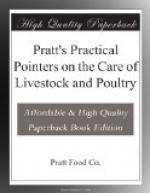“No branch of live-stock farming gives better results than the raising of well-bred swine when conducted with a reasonable amount of intelligence. The hog is one of the most important animals to raise on the farm, either for meat or for profit, and no farm is complete unless some hogs are kept to aid in the modern method of farming. The farmers of the South and West, awakening to the merits of the hog, are rapidly increasing their output of pork and their bank accounts. The hog requires less labor, less equipment, less capital, and makes greater gains per hundred pounds of concentrates than any other farm animal, and reproduces himself faster and in greater numbers; and returns the money invested more quickly than any other farm animal except poultry.”
The University of Minnesota, in Extension Bulletin 7, sums up the matter as follows:
“From a business point of view, the hog is described as a great national resource, a farm mortgage lifter and debt-payer, and the most generally profitable domesticated animal in American agriculture.”
And this summarizes the general opinion of progressive hog growers and the experts connected with the United States Department of Agriculture and the various State Agricultural Experiment Stations and Colleges.
Breeds of hogs are divided into two general classes—bacon type and lard type. Where milk is plentiful, and especially where such foods as barley and peas are grown, the bacon type will be the most profitable, as they furnish the largest litters and also make pork that brings the best price in the market. The lard type of swine are usually kept where corn is the cereal that is most grown.
The large Yorkshire and Tamworth are the leading bacon breeds. The Poland China, the Duroc Jersey, and the Chester White are leading lard types. The Berkshires, Cheshires, and Hampshires are intermediate between the bacon and lard types. When bacon sires are crossed upon sows of any of the other breeds, the progeny are excellent for pork.
The farmer who is about to adopt a breed should be sure to select one of the standard and common breeds of his own neighborhood. Many men make the mistake of introducing a breed new to the section, and when the time comes that a new boar must be secured much difficulty and expense are incurred before a satisfactory one can be found.
The bulletin quoted above further says: “To the production of pork, then, in the largest amount, in the shortest time, and with the minimum of money and labor, all the details of the hog-raising industry are directed.” Here is the whole secret—pork in largest amount, in shortest time, at lowest production costs. And the very foundation is perfect health and vigorous condition of the hogs, both breeding animals and market stock.
Health and vigor are necessary in the breeding animals if they are to produce big litters of sturdy pigs—in the market animals if they are to consume large amounts of food and economically and quickly convert it into fat and muscle. Weak, sickly, run-down hogs are a constant source of trouble and are never profitable under any conditions. Disease is one of the greatest drawbacks in the hog industry.




